#8x8_shangrila_23 Visual Artists
Noa Dettweiler
Kāloa: The Fertile Crescent, 2022
Ceramic Stoneware, Brass, Wood
Upper Lawn
This sculpture employs the crescent moon and star motif seen throughout the Muslim sphere of influence to celebrate the Hawaiian lunar phase of Kāloa. Hawaiians recognize the three Kāloa crescent moons as a peak time to gather shellfish; once abundant in the reefs and along the shoreline of Hawai‘i’s coasts, including at Ka‘alāwai, the traditional name for the land upon which Shangri La is situated. The base of this piece is carved from a section of a shower tree that once graced Shangri La’s grounds. Treated in the shou sugi ban method, the magenta-black carbonized wood tones reflect the deepest recesses of the ocean, realm of the Hawaiian god Kanaloa.
The Kāloa moons are dedicated to Kanaloa, who is also represented by the stylized he‘e (octopus) tentacles supporting the sculpture’s crescent moon. The ‘ōpihi (limpet), a choice shellfish delicacy to Hawaiians, are symbolic of the moon’s rugged surface. In homage to the Persian lusterware found throughout Shangri La, the ‘ina kea (sea urchin) topping this sculpture evokes a distant star sparkling in a Kāloa night sky.
Noa Dettweiler
Working out of both his home studio and the Hawai‘i Potters’ Guild, Noa Dettweiler-Pavia throws and handbuilds ceramic pieces that embraces what he calls a “dys+functional” aesthetic. Noa’s work is built upon stories and experiences of his Waimanalo upbringing and incorporation of native pālolo (clay) binds his pieces to Hawai‘i, his ‘āinahānau (birthland). Noa is a practicing attorney, having received his juris doctorate from the University of Hawai‘i at Mānoa’s William S. Richardson School of Law.
Daven Hee
Red/Orange/Yellow/Green/Blue, 2022
Wheel-thrown Stoneware with Underglazes, Glaze and Luster
Introductory Gallery
“Visiting Shangri La, I was intrigued with the ceramic and glass vessels. I’ve always been interested in the mindset of the unknown craftsperson. What was their process? Who were they? What was the functionality behind the forms? Were they used?
For #8x8, I’ve made forms that are functional but mostly decorative. I’ve made ceramics pieces that look like glass, and rather than trying to make each piece perfect, similar to the unknown craftsperson who made pieces for basic day to day use, I tried to let the imperfections make the piece, no fuss.”
Daven Hee
Daven Hee is a local potter and ceramic artist from the island of O‘ahu. Born in Honolulu and raised with traditional Japanese and Chinese values, Daven was officially told in high school that he was meant to be either a farmer or a circus performer.
Instead, Daven grows pots and entertains his students at Mid-Pacific, an arts-focused private school in Honolulu, Hawai‘i, where he serves as instructor of ceramics and leads the 3D art program. Prior to COVID-19 times, Daven could also be found teaching at the Honolulu Museum of Art School, the Hawai‘i Potters'’ Guild, and the University of Hawai‘i at Mānoa.
Alongside mentoring students of all ages, Daven maintains an active studio practice. His work can be found in permanent and private collections nationally and internationally, including at the Honolulu Museum of Art, the Hawai‘i State Foundation on Culture and the Arts, and the National Institute for the Arts, Australian National University.
Daven holds a Master of Arts in the Visual Arts (MAVA) from the Australian National University School of Art & Design, where he studied with Janet De Boos and Greg Daly, and earned his Bachelor of Fine Arts (BFA) degree from the University of Hawai‘i at Mānoa.
Fuki Ikeuchi
Night Waves and Sea Petals, 2022
Glazed Ceramic Pieces Strung on String Mounted Inside Shadow Boxes
Mughal Gallery
These ceramic pieces are inspired by the cobalt and turquoise Mihrab panel at Shangri La. Ikeuchi was drawn by the ability of the Mihrab to attract and reflect light using color and luster. They are displayed in the Mughal Gallery as part of her works explores cultural collaboration and influence that provides a greater sense of purpose and inspiration for life. “Symbolically, jewelry is a powerful reminder of our connections to our ancestral past, to those who support us, can transport us to important memories, helps us to feel empowered, and to have hope in facing the future.”
Fuki Ikeuchi
Fuki Ikeuchi, born and raised in Japan, has been working in ceramics for the past eight years. She has shown work in local exhibitions, and her work can be found in private collections locally, nationally, and internationally. Her work explores the play between patterns, mark making, and forms. Her work also reflects her belief in cross-cultural collaboration and integration using texture and color to create exciting surfaces through the application of slips, oxides, and glazes to stoneware and porcelain clays.
Janet Kelly
Ocean Arabesque, 2022
Ceramic Vases with Cobalt Oxide
Dining Room
Inspired by the arabesque motifs of intertwined vegetation and curved lines in the tiles at Shangri La, and the ocean fronting the property, Kelly uses cobalt oxide over white glaze to saturate the surface of her pots with bold strokes to capture the motion of the ocean. Kelly also wanted to connect to pottery’s long history of using cobalt blue glazes which became popular in Islamic pottery during the 8th century and continues to inspire potters from a myriad of cultural backgrounds into modern times.
Janet Kelly, born and raised in Honolulu, Hawai‘i, has studied art at the Hawai‘i Potters’ Guild, the Honolulu Museum of Art School, and the University of Hawai‘i. She works in a variety of media, including glass, photography print making and ceramics, but has focused most of her work in ceramics for the last 15 years. She has exhibited locally and internationally. She is currently the President of the Hawai‘i Potters’ Guild. Her work reflects her belief in balancing the overstimulation and stresses of modern life with the calming nature of working in ceramics – the wedging of the clay, the rotation of the wheel, the stirring of glaze – to communicate the compelling and subtle difference in each handmade piece.
Jack Lewin
Untitled, 2022
Ceramic Vases with Cobalt Oxide
Central Courtyard
These wheel thrown, stoneware vessels are glazed with (from right to left): Shino and Kiawe wood ash, copper green raku, and Jack Troy. Each piece was chosen to complement the tones and textures of the central courtyard, from the earthy oranges to the bright luster tones seen throughout Shangri La. The stamped piece on the left is especially significant to Jack: “I was so inspired by all of the textures and patterns on my tour of Shangri La that I wanted to make something that reflected patterns and textures. I used my favorite stamp to texture and create a patten on the outside of the pot.”
Jack Lewin
Born in Nebraska, Jack moved to Hawai‘i as a teenager where he took ceramic courses in high school and college. Later in life he picked it up again at the Ala Wai Community Center and the Hawai‘i Potters' Guild. There, Jack has had the chance not only to take classes under several instructors, but also to learn to fire kilns, make glazes, and further his ceramic experiences.
“My work is a simple exploration of clay, shapes, and glazes. The joy of ceramics for me is to be creative, and to explore the many possibilities with in the craft.”
Faye Maeshiro
Empty Vessel Series 1, 2022
Ceramic Vases with an Encaustic Finish
Qajar Gallery
These sculptural vases are inspired by the mosaic, lattice, and calligraphic work at Shangri La. Seemingly “empty,” but full of shadow and light, the vessel shapes mimic an earlier type of medieval metalwork called a pilgrim’s flask, used by voyagers on long journeys. The openwork lattice of the vessels informed their display in the Qajar Gallery, with its significant jali (lattice work screens) as well as the cool blue tones of much of the artwork on display.
Faye Maeshiro
“I am a musician by schooling and am artist by heart”. A 1978 graduate of Berklee College of Music - with a major in Music Composition, and minor in Piano - Faye started ceramics later in life at the Hawai‘i Potters'’ Guild and continues to study under some of the best local ceramic artists, including Aaron Padilla, Daven Hee, and currently Ken Kang.
She is drawn to sculptural forms and textures that can be created on the surface of clay by carving, stamping, or the addition of mixed media.
Harinani Orme
Manu-o-Kū: Shangri La's Living Treasure, 2022
Painted and Glazed Tile Mosaic
Private Garden
This piece invites visitors to explore, reflect and enjoy the unique depiction of flora and fauna found in the tile work of Shangri La’s Central Courtyard. These handcrafted tiles are inspired by the decorative traditions of Islamic tile design and patterning, and by depicting the Manu-O-Ku birds at Shangri La. Designated as the official bird of the city of Honolulu in 2007, this bird has great relevance for our islands as a guide for Polynesian voyagers. The story of this elegant seabird, told in Doris Duke’s private garden, captures the spirit and atmosphere of Shangri La by its grace and beauty.
Harinani Orme
Born and raised in Hawai’i, on the island of Oahu, Harinani Orme earned a Bachelor of Fine Arts degree at the University of Hawai’i at Manoa and a Master of Fine Arts degree at the Pratt Institute in New York.
Art educator, printmaker, painter, illustrator, ceramicist and mixed media artist, Harinani Orme often employs a collage approach in her creative process, combining a strong narrative element, interesting and unique composition, color and patterns. Currently, her works focus on the myths, legends, and traditions of Hawaiʻi in wā kahiko, using her printmaking and painting skills to infuse certain graphic characteristics for fuller expression of this narrative style.
“I am a visual interpreter, sharing moʻolelo of our island people rooted in mythic events, both ancient and modern. Through print, paint, clay, and found objects, I translate deeply researched stories. The practice of making these works is immersive, leading others and myself deep into Hawaiian culture. I am proud to be Hawaiian. In creating each piece, I move towards reconnecting to my culture.”
Roy Yamashiro
Untitled, 2022
Ceramic Vases
Ottoman Gallery
The upward spiraling surface of this ceramic water storage jar represents the arid lands of where Islam was founded and the ever-changing blue ocean fronting Shangri La and around the State of Hawai‘i that the Hawaiians and our ancestors crossed to come from afar. The spiral provides the upward bias of the continuum. The water storage jar relates to the importance of water in the birth of Islam, in the ritual of purification with water before entering a mosque (ablution), to the water feature in the Ottoman Gallery, and provokes thoughts of how precious water is here in Hawai‘i and throughout the world.
Roy Yamashiro
Roy Yamashiro is a structural engineer whose firm has done projects across Hawai‘i and the Pacific Basin. He received his BS in civil engineering from the University of Hawai‘i and his MS in structural engineering from the University of Illinois. He has always been interested in ceramics and began “throwing” on the potter’s wheel at the Hawai‘i Potter’s Guild about ten years ago.
“My travels have allowed me to experience the beauty of Islamic architecture and art in Istanbul, Turkey; Seville, Granada and Cordoba, Spain; Agra, India; and Dubai, United Arab Emirates. My structural engineering background was enriched after visiting the Aya Sofia, Blue Mosque, Topkapi Palace, mosque of Suleman the Magnificent, the Alhambra, the mosque that was converted into a Christian church in Cordovb, and of course the most beautiful of Islamic architecture, the Taj Mahal. I marveled at uniquely shaped buildings and spaces that expressed the beauty of vast empty spaces used for public prayer.”
































